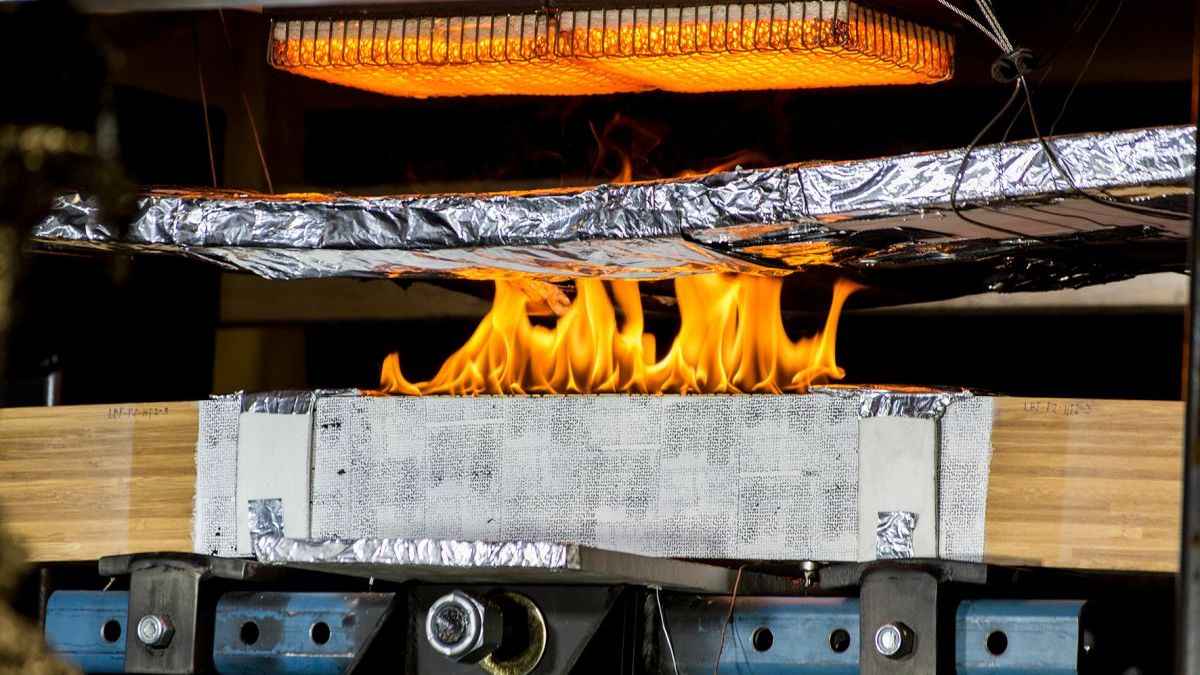
Modern load-bearing structures consisting of laminated mass timber columns, walls, and floors are most times constrained serviceability or fire performance.
Fire-induced failure mechanisms of load-bearing structures are known to be governed by a reduction of cross-section, more specifically induced by charring, and/or loss of load-bearing capacity of timber, and/or loss of composite action between lamellas, and/or lamellas’ fall-off during fire, and/or weakening of the connecting conditions of structural elements. Assuring structural integrity during and after fire is key for demonstrating an appropriate fire performance of timber structures in which fire considerations are relevant, e.g. tall timber structures.
This Future Timber Hub project investigates the behaviour of a prototype hybrid Timber-FRP (Fibre Reinforced Polymer) with enhanced fire and serviceability performance; exploring effective fabrication techniques for load-bearing floor systems.
The discovery of a novel Timber-FRP fabrication technique that can effectively be manufacture at an industrial scale has been at the core of this work. Outcomes of experimental and modelling studies completed to date have explored varied fabrication techniques that efficiently combine FRP and timber; in terms of ease of fabrication, time of fabrication, and material cost. Experimental results have shown that the prototype hybrid Timber-FRP can result in 100% increase for the time-to-failure during a fire and a 15% for the bending stiffness during normal service conditions. This enables the design and construction of load-bearing mass timber floor structures with enhanced performance and/or increased spans and/or reduced dimensions (e.g. shallower depth of beams).
The challenge in developing such kind of hybrid elements was to find an efficient way to combine the superior properties of the FRP material by impeding it inside the timber to be protected from the direct fire exposure. The novel fabrication techniques relate to the lodging of FRP strips (details of this new fabrication are currently pending patent) during the typical lamination procedure, with minimal impact to the typical fabrication processes of laminated timber (temporal and economical cost). As a result, we will be able to fabricate and build timber structures that have smaller structural sections with equivalent or better performance, and to deliver unique modern architectural designs for timber structures in a more confident way, with less limitations due to fire. The research is unique because it requires a multidisciplinary collaboration between the timber manufacturing sector, the FRP specialists, and the structural and fire safety engineering sectors.
Abdulrahman Zaben is the PhD candidate at The University of Queensland leading key studies associated with this project. Moreover, the following Master thesis have resulted within the scope of this project:
- Michael Cheung (2020) Investigating the effects of elevated temperatures adhesives used in laminated timber at elevated temperatures
- Bernabe Zaragoza (2019) Finite Element modelling of a hybrid Timber-FRP floor system
- Sohan Roopra (2018) Conceiving a Fabrication Technique for a Fire Safe Timber-FRP Composite (now Engineer at Arup, Brisbane)
- Harrison Wall (2017) Proof-Of-Concept for a Fire Safe Timber-FRP Composite Load-Bearing System (now Engineer at Omnii, Brisbane)
- Rukesh Shilpakar (2016) Heat-Induced Delamination of Laminated Timber

Abdulrahman Zaben
PhD Candidate
The University of Queensland
Research Showcase
Key Articles & Conference Presentations
- Zaben A, Bailleres H, Vella R, Fernando D, Lange D, and Maluk C. (2020) Exploratory study for the fire performance of prototype hybrid Timber-FRP Glulam beam with different reinforcing techniques. 10th International Conference on FRP Composites in Civil Engineering (CICE 2020), Turkey, 30th June – 2nd July 2021. (accepted for oral presentation)
- Zaben A, McGavin R, Bailleres H, Fernando D, Lange D, and Maluk C. (2020) Fire performance of a prototype Timber-FRP Glulam beam. World Conference on Timber Engineering (WCTE 2020), Chile, 11th – 14th January 2021. (accepted for oral presentation)
- Zaben A, Lange D, and Maluk C. (2020) Compressive strength and MoE of solid softwood at elevated temperatures. 11th International Conference on Structures in Fire (SiF 2020), Australia, 30th November – 2nd December 2020. (accepted for oral presentation)
- Soils B, Zaben A, Lange D, Fernando D, and Maluk C. (2019) Fire safe prototype Timber-FRP hybrid Glulam beam – exploratory studies. 7th Asia-Pacific Conference on FRP in Structures (APFIS 2019), 10th – 13th December 2019, Australia.
- Zaben A. (2019) Timber-FRP Glulam beam prototype – Fire Performance Proof of Concept. 3rd Young Researchers’ Conference – Institution of Structural Engineers (IStructE) Australia Regional Group, 29th November 2019.
- Zaben A, Roopra S, Bailleres H, Lange D, and Maluk C. Effects of charring for prototype composite FRP-Timber Glulam beam. Applications of Structural Fire Engineering (ASFE’19), 13th – 14th June 2019, Singapore.
- Zaben A, Lange D, Fernando D, and Maluk C. Fire performance of a prototype Timber-FRP hybrid Glulam beam. 5th Pacific Timber Engineering Conference (PTEC), 10th – 12th July 2019, Australia.
- Wall H, Fernando D, and Maluk C. (2018) Fire performance of Glulam-FRP composite – Proof of Concept. World Conference on Timber Engineering (WCTE 2018), 20th – 23rd August 2018, Republic of Korea.
Expand knowledge on the fire performance of laminated mass timber floor systems.
Research and develop a prototype hybrid Timber-FRP with enhanced fire and serviceability performance.
Validate engineering design tools used for demonstrating structural integrity of typical laminated mass timber floor systems.




